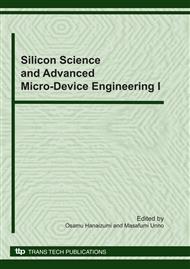[1]
O.J.M. Smith, A controller to overcome dead-time, ISA Journal, Vol. 6, pp.28-33. (1959).
Google Scholar
[2]
S. Sawano, Analog study of process-model control systems, Journal of the Society of Instrument and Control Engineers, Vol. 1, pp.198-203. (1962).
Google Scholar
[3]
C.C. Hang and F.S. Wong, Modified Smith predictors for the control of processes with dead time, Proc. ISA Annual Conf., pp.33-44. (1979).
Google Scholar
[4]
K. Watanabe and M. Ito, A process-model control for linear systems with delay, IEEE Transactions on Automatic Control, Vol. 26, pp.1261-1266. (1981).
DOI: 10.1109/tac.1981.1102802
Google Scholar
[5]
K. Watanabe and M. Sato, A process-model control for multivariable systems with multiple delays in inputs and outputs subject to unmeasurable disturbances, International Journal of Control, Vol. 39, pp.1-17. (1984).
DOI: 10.1080/00207178408933145
Google Scholar
[6]
A.M. De Paor, A modified Smith predictor and controller for unstable processes with time delay, International Journal of Control, Vol. 41, pp.1025-1036. (1985).
DOI: 10.1080/0020718508961181
Google Scholar
[7]
P.B. Deshpande and R.H. Ash, Computer process control with advanced control applications, ISA Pub. (1988).
Google Scholar
[8]
A.M. De Paor and R.P.K. Egan, Extension and partial optimization of a modified Smith predictor and controller for unstable processes with time delay, International Journal of Control, Vol. 50, pp.1315-1326. (1989).
DOI: 10.1080/00207178908953435
Google Scholar
[9]
K.J. Astrom, C.C. Hang and B.C. Lim, A new Smith predictor for controlling a process with an integrator and long dead-time, IEEE Transactions on Automatic Control, Vol. 39, pp.343-345. (1994).
DOI: 10.1109/9.272329
Google Scholar
[10]
M.R. Matausek and A.D. Micic, A modified Smith predictor for controlling a process with an integrator and long dead-time, IEEE Transactions on Automatic Control, Vol. 41, pp.1199-1203. (1996).
DOI: 10.1109/9.533684
Google Scholar
[11]
K. Watanabe, A new modified Smith predictor control for time-delay systems with an integrator, Proceedings of the 2nd Asian Control Conference, Vol. 3, pp.127-130. (1997).
Google Scholar
[12]
H.J. Kwak, S.W. Sung, I.B. Lee and J.Y. Park, A modified Smith predictor with a new structure for unstable processes, Ind. Eng. Chem. Res., Vol. 38, pp.405-411. (1999).
DOI: 10.1021/ie980515n
Google Scholar
[13]
G. Zames, Feedback and optimal sensitivity: model reference transformations, multiplicative seminorms, and approximate inverses, IEEE Transactions on Automatic Control, Vol. 26, pp.301-320. (1981).
DOI: 10.1109/tac.1981.1102603
Google Scholar
[14]
D.C. Youla, H.A. Jabr and J.J. Bongiorno, Modern Wiener-Hopf design of optimal controllers. Part I, IEEE Transactions on Automatic Control, Vol. 21, pp.3-13. (1976).
DOI: 10.1109/tac.1976.1101139
Google Scholar
[15]
C.A. Desoer, R.W. Liu, J. Murray and R. Saeks, Feedback system design: The fractional representation approach to analysis and synthesis, IEEE Transactions on Automatic Control, Vol. 25, pp.399-412. (1980).
DOI: 10.1109/tac.1980.1102374
Google Scholar
[16]
M. Vidyasagar, Control System Synthesis-A factorization approach-, MIT Press. (1985).
Google Scholar
[17]
M. Morari and E. Zafiriou, Robust Process Control, Prentice-Hall. (1989).
Google Scholar
[18]
J.J. Glaria and G.C. Goodwin, A parameterization for the class of all stabilizing controllers for linear minimum phase plants, IEEE Transactions on Automatic Control, Vol. 39, pp.433-434. (1994).
DOI: 10.1109/9.272352
Google Scholar
[19]
K. Yamada, A parameterization for the class of all proper stabilizing controllers for linear minimum phase systems, Preprints of the 9th IFAC/IFORS/IMACS/IFIP/ Symposium on Large Scale Systems: Theory and Applications, pp.578-583. (2001).
DOI: 10.1016/s1474-6670(17)40875-5
Google Scholar
[20]
E. Nobuyama and T. Kitamori, Spectrum assignment and parameterization of all stabilizing compensators for time-delay systems, Proceedings of the 29th Conference on Decision and Control, Honolulu, Hawaii, pp.3629-3634. (1990).
DOI: 10.1109/cdc.1990.203509
Google Scholar
[21]
E. Nobuyama and T. Kitamori, Parameterization of all stabilizing compensators in time-delay systems, Transactions of the Society of Instrument and Control Engineers, Vol. 27, pp.1115-1122. (1991).
DOI: 10.9746/sicetr1965.27.1115
Google Scholar
[22]
K. Yamada, H. Takenaga, T. Hagiwara, Y. Ando and I. Murakami, A design method for stabilizing modified Smith predictor for non-minimum-phase time-delay plants, submitted for publication.
Google Scholar


